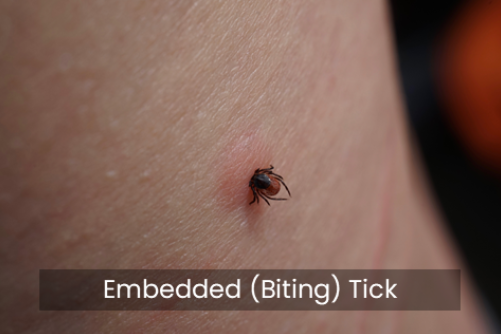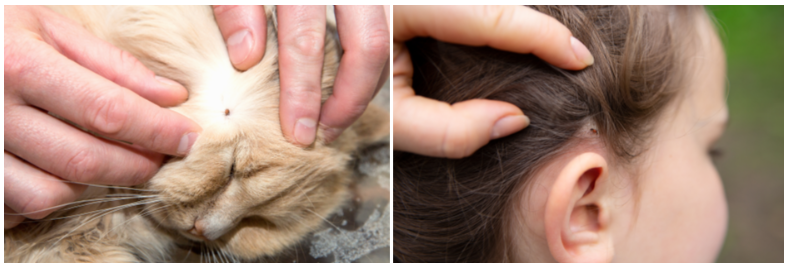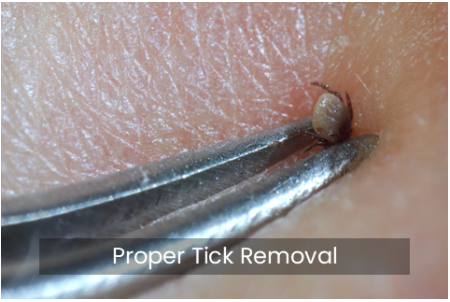
Tick Talk: Where They Are, What They Carry, and How to Ditch Them
Get ready for perhaps the worst tick season ever. Thanks to warmer winters, shifting wildlife patterns, and a bumper crop of deer and rodents, tick populations are exploding across the US in 2025 — even in areas where people don’t usually worry much about them. From suburban backyards to urban parks, these little hitchhikers are turning up in places they didn’t used to roam, and they’re bringing some unwelcome baggage. More ticks mean more tick bites and more tick-borne diseases, which are no joke.
You can get bitten by a tick at any time of year, especially in warmer climates. But spring, summer and early autumn are busy tick seasons. Since this year will be busier than most, we’ve put together a survival guide (for you, not the ticks) with all the information you need to avoid tick-borne misery.
Some Facts and Perspective
Ticks are parasites, in the spider family, that feed on warm-blooded hosts, basically us and our pets, by biting. A tick bite can infect us with bacteria and viruses that can cause diseases. Some of these conditions can be very serious, and that’s why ticks are so scary.
Tick-borne diseases get tons of attention — and for good reason. They’re dangerous, and we can get bitten when we’re engaged in otherwise risk-free activities. But before you vow to stay away from anything green all summer, consider this:
- Ticks need to bite you to make you sick. So, if you find a tick while it is still crawling, it has not infected you.
- It takes more than a few hours of attachment for a tick to transmit disease. According to the CDC, your risk is very low if the tick has been attached for fewer than 24 hours. This gives us a fighting chance to stay healthy.
- Only a fraction of ticks carry disease. Depending on the type of tick, its location, and its age, that fraction could be as little as 1% or as much as 50%. Unfortunately, an estimated 50% of blacklegged ticks in the Northeast carry Lyme disease.
What Exactly Happens When You Get a Tick Bite? (Warning, “Ick” Alert!)
Ticks can easily get onto any part of your body, then crawl to their preferred places — usually areas with soft skin and plenty of blood. You are not likely to feel a tick bite and you might not see a tick that has bitten you until it has fed on your blood and become larger. Baby ticks can be the size of a poppy seed, but they can still bite.

Once the tick bites you, it feeds on your blood in much the same way as a mosquito does. But unlike the mosquito, a tick will stick around. The longer a tick is attached, the bigger it gets and the higher the risk of you getting a tick-borne disease. Also, unlike mosquito bites, which almost always cause itching, tick bites are often itch-free.
A tick bite may not cause any skin reaction — but if it does, it could be a sign of a tick-borne disease. For example, a rash that looks like a bullseye is an early indicator of Lyme disease, even though the actual infection may not cause systemic problems until weeks later. Most tick-borne diseases will cause flu-like symptoms and may include more specific issues like joint pain or upset stomach.
The Scariest Common Ticks – Where They Live and What Diseases They Carry

- Blacklegged (deer) ticks: They don’t really have black legs, but they do usually sport a contrasting oval on their backs. Deer ticks are found mostly in the Northeast, upper Midwest, and now through parts of the South. They carry Lyme disease, and the flu-like diseases anaplasmosis, babesiosis, and ehrlichiosis.
- Lone Star ticks: They get their name from the single white dot (decidedly not star-like) found on their backs. They are most common in the Southeast and eastern US. They can transmit ehrlichiosis and cause alpha-gal syndrome (a bizarre, sometimes deadly, allergy to red meat).
- American dog ticks: They are quite common and can often sport a tortoise-shell type look. They are found across most of the US, especially in grassy areas east of the Rockies. They spread Rocky Mountain spotted fever.
Where Ticks Are Hiding
Ticks like shady, humid areas: tall grasses, wooded trails, leaf litter, and even overgrown lawns. They don’t fly or jump, but they are very patient climbers. They hang out on blades of grass with their front legs stretched out like tiny hitchhikers, waiting for you (or your dog) to brush by. The point is you don’t need to be hiking in the woods to encounter ticks. They can be living happily in your backyard or in your local city park.
While different types of ticks have always been more prevalent in certain parts of the country, today’s most dangerous ticks would be spreading their wings if they had them. Deer, or black-legged ticks, indigenous to the Northeast are turning up in the Midwest and even in Texas. Lone Star ticks are showing up as north as Maine. And brown dog ticks can be found in every state in the mainland US.
Your Best Defense – Tick Avoidance
- Treat clothing and gear with products containing 0.5% permethrin. Permethrin can be used to treat boots, clothing, and camping gear, and remain protective through several washings. Alternatively, you can buy permethrin-treated clothing and gear.
- Protect your pet! There are tons of options for dogs, including oral and topical solutions as well as chemically treated flea/tick repellent collars. Outdoor cats have it a little tougher because cats are much more sensitive to strong chemicals. Check with your vet to see what’s best for your pet, because pets can contract tick-borne diseases.
- Cover up: Wear long sleeves and pants. Tuck your pants into your socks (hot and unfashionable, but effective).
- Use insect repellent with DEET, picaridin, or oil of lemon eucalyptus. If you are using sunscreen, apply sunscreen first and insect repellent second (although you should be too covered up to need sunscreen!).
- Stick to the center of trails when hiking.
- Keep your yard tick unfriendly: Mow the lawn regularly, trim back brush, and create a tick-safe zone by placing a 3-foot gravel barrier between wooded areas and your lawn. If you live near woods, consider tick control treatments around your home’s perimeter. Discourage unwelcome animals (such as deer, raccoons, and stray dogs) from entering your yard by constructing fences. Remove old furniture, mattresses, or trash from the yard that may give ticks a place to hide.
- Keep playground equipment, decks, and patios away from yard edges and trees.
Checking for Ticks
During outdoor activities, regularly check your exposed skin and clothing for ticks. When you are outside in tick-friendly areas, experts say you should stop and check for ticks every 10-15 minutes! That may seem excessive, but ticks are fast movers before they bite and take root. The idea is to spot them before they get to a more hidden tick-friendly spot on your body. Carry tweezers! Ticks that are found should obviously be removed (more on this below), and tweezers are the tool of choice. Carry a pair with you!
Examine gear and pets before returning indoors. Ticks can ride into the home on clothing and especially on pets, then attach to a person later, so carefully examine coats, daypacks, and your pets every time they’ve been outside during tick season. Pets are also less likely to avoid tick-friendly areas, so they can easily bring home some unwanted guests. Check your pets everywhere, but especially in their hot spots:
- In and around the ears
- Around the eyelids
- Under the collar
- Around the tail
- Under the front legs
- Between the back legs

Check your head and body for ticks after being outdoors. Don’t just focus on areas where ticks are commonly found. Ticks range in size from 1–2 millimeters (mm) in diameter (the size of a poppy seed) to as large as 10 mm in diameter (the size of a pencil eraser).
Conduct a full body check upon return from potentially tick-infested areas, including your own backyard. Use a hand-held or full-length mirror to view all parts of your body. Favorite spots in humans are similar to favorite spots in pets. Check these parts of your body and your child’s body for ticks:
- Under the arms
- In and around the ears
- Inside belly button
- Back of the knees
- In and around the hair
- Between the legs
- Around the waist
For Additional Peace of Mind
- Put your dry clothes into a dryer on high for at least ten minutes (longer if your clothes are damp) to kill any ticks you may have missed.
- After doing a full tick check, take a hot shower. You may rinse off any unembedded ticks you may have missed.
Dos and Don’ts For Removing Ticks (Sorry, but you really need to know this!)

- If you find a tick embedded on yourself or your pet, use fine-tipped tweezers to pull it straight out.
- Position the tweezers directly under the spot where the tick is attached to the skin. Grasp the tick close to the skin’s surface to avoid squeezing the tick’s body.
- Pull the tick away from the skin with steady, even pressure.
- Don’t twist or jerk the tick. This can cause the tick mouthparts to break off and remain in the skin. If this happens, your body will naturally push the mouthparts out over time as your skin heals. You can also remove the mouthparts with tweezers. If you cannot remove the mouthparts easily with tweezers, leave them alone.
- Dispose of the live tick by taking one of these steps: wrap it tightly in tape; flush it down the toilet; or put it in alcohol. Alternatively, place the tick in a tightly sealed container or plastic bag for testing purposes in the event that you develop symptoms.
- Do not crush the tick with your fingers. If it is carrying infectious bacteria you will risk transferring it.
- After removing the tick, thoroughly clean the bite area and your hands with soap and water, rubbing alcohol, or hand sanitizer.
- If you see a rash (especially a bullseye), get a fever, or feel like you have the flu during the next few weeks, call your doctor.
Do NOT try to smother a tick with nail polish, oil, or petroleum jelly. Don’t try to burn it. You will be doing more damage to yourself that to the tick.
Worst Case Scenario – A Home Infestation (Warning “Skeeve” Alert)
If a tick is brought into your home, and not seen or removed, it can easily cause an infestation. This is most likely to happen if a tick falls off clothing or a pet’s fur without biting. A single tick can reproduce and create an invasion of tiny biters. Ticks can lay eggs pretty much anywhere in a home, but they typically lay their eggs near baseboards, window and door frames, furniture, edges of rugs, and curtains.
Once hatched, ticks can’t live without blood from people or animals. So, the invaders will find bodies, most likely those of children or pets. Remove them carefully, as explained above.
Ticks that aren’t attached to the skin can be vacuumed up. The vacuum bag should be tightly sealed and immediately discarded to a location outside of your home. You should check your clothing and body after vacuuming to ensure no ticks are on you. You may also use spray or powder pesticide to help kill ticks inside your home.
Although it’s possible to control a tick infestation once it occurs, it’s far better to prevent an infestation from happening. This is why we can’t stress enough how important it is to check yourself, your children, and your pets before going indoors.
The Bottom Line
In short: ticks are tiny, sneaky, and kind of terrifying. But with a little awareness, some basic preparation, and a good pair of tweezers, you can enjoy the great outdoors without turning into an accidental buffet. Consider this your bite-sized insurance policy against a summer of itching, and possibly antibiotics.